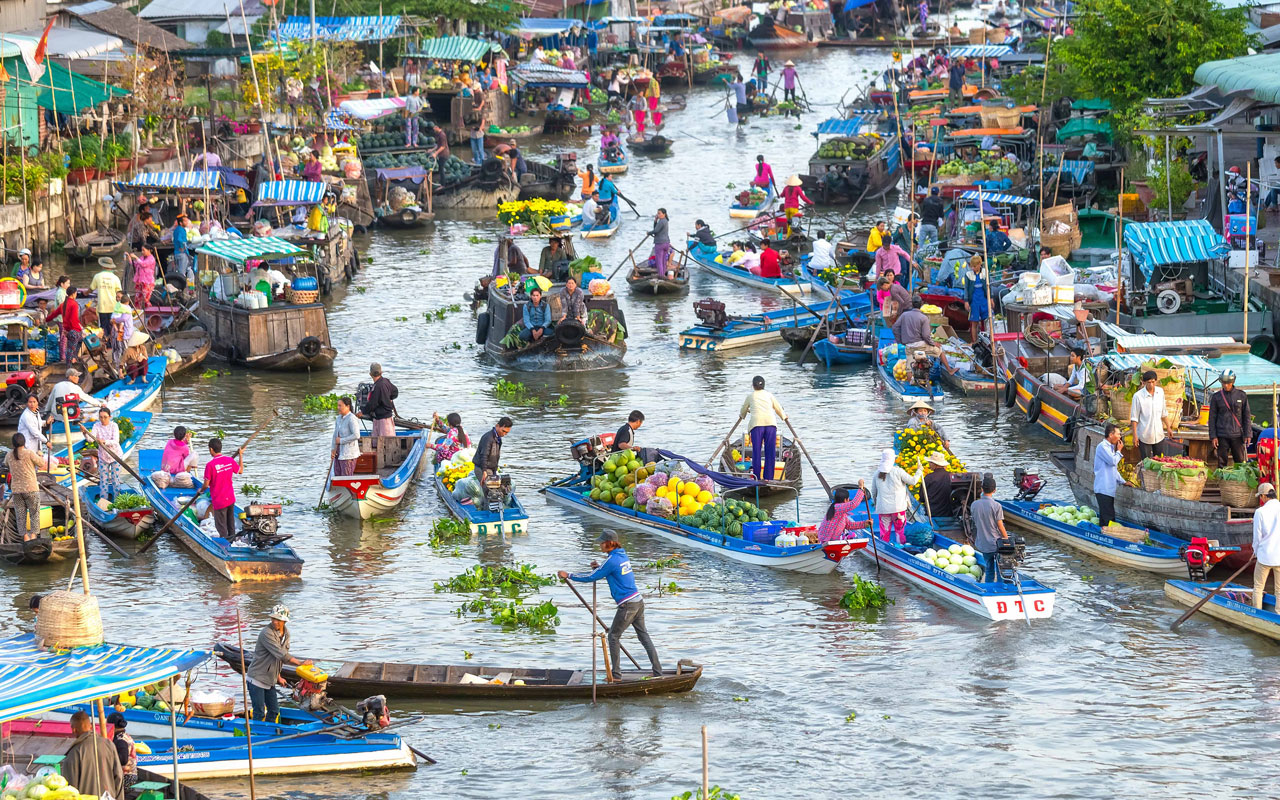
Vietnam is a nation of intriguing contrasts, where the blend of timeless traditions and contemporary aspirations creates a lively and varied society. You can delve into its captivating history, journeying from the imperial citadels of Hue and Hanoi to the historical relics of Ho Chi Minh City and the Cu Chi tunnels. Natural marvels also await, from the breathtaking Halong Bay and the lush Mekong Delta to the majestic Fansipan mountain. For food enthusiasts, Vietnam is a paradise boasting the delicate delights of pho, banh mi, spring rolls, along with abundant seafood and tropical fruits. Whether you're drawn to urban energy or rustic allure, Vietnam's allure lies in its enthralling landscapes and rich culture. In this guide, you'll be accompanied by Vicky, a seasoned travel consultant from TravelVietnam.com. Vicky specializes in curating tours across Vietnam and Southeast Asia, including destinations like Thailand, Cambodia, and Laos. Together, we'll navigate your journey through Vietnam in 2024, offering insights on the optimal time to visit, travel arrangements, accommodation options, packing tips, transportation guidance, and a comprehensive list of must-see and must-do experiences. Additionally, we'll feature invaluable advice from fellow travelers who've explored Vietnam and our team to help you make the most of your adventure.
Things to Know about Vietnam
| Fact | Description |
|---|---|
| Capital of Vietnam | Hanoi |
| Largest city in Vietnam | Ho Chi Minh City (formerly known as Saigon) |
| Population of Vietnam | 99,052,571 as of April 2024 |
| Official currency in Vietnam | Vietnamese dong (VND) |
| Official language of Vietnam | Vietnamese |
| Major religions in Vietnam | Buddhism, Christianity, Hinduism, Cao Daiism, Hoa Haoism |
| Life expectancy in Vietnam | 73 years (male), 77 years (female) |
| Literacy rate in Vietnam | 95% |
| Major exports from Vietnam | Electronics, garments, footwear, seafood, rice, coffee |
| Major imports to Vietnam | Machinery, electronics, fuel, chemicals, plastics |
| National Day of Vietnam | September 2 |
| Famous landmarks in Vietnam | Halong Bay, Hoan Kiem Lake, Cu Chi Tunnels, Hue Imperial City, My Son Sanctuary |
| Popular tourist destinations in Vietnam | Hanoi, Ho Chi Minh City, Nha Trang, Da Nang, Phu Quoc |
| UNESCO World Heritage Sites in Vietnam | Halong Bay, Phong Nha-Ke Bang National Park, Hue Monuments, Hoi An Ancient Town, My Son Sanctuary |
| Intangible cultural heritage of Vietnam | Water puppetry, Quan họ folk singing, Nha Nhac court music, Ca trù singing, Don Ca Tai Tu music |
| Vietnam Timezone | GMT + 7 (Asia/Ho_Chi_Minh) |
| Current Local Time in Hanoi, Vietnam: | |
Vietnam is a Southeast Asian country with a rich history, diverse culture, stunning landscapes, and delicious cuisine. It is famous for its natural wonders like Ha Long Bay, its historic landmarks like the Cu Chi Tunnels, and its vibrant cities like Hanoi and Ho Chi Minh City. Vietnam is also known for its flavorful dishes like pho, its unique coffee culture, and its colorful festivals like Tet Nguyen Dan.
In general, here are some things that Vietnam is known for:
- Its beautiful beaches, lush rice paddies, towering mountains, and stunning landscapes like Ha Long Bay
- Its culture, history, and heritage, influenced by Chinese, French, and American colonization
- Its flavorful cuisine, especially street food and Vietnamese coffee.
- Its friendly and hospitable people
- The Vietnam War and its aftermath, including the Cu Chi Tunnels and historical cities
Best Time to Travel to Vietnam
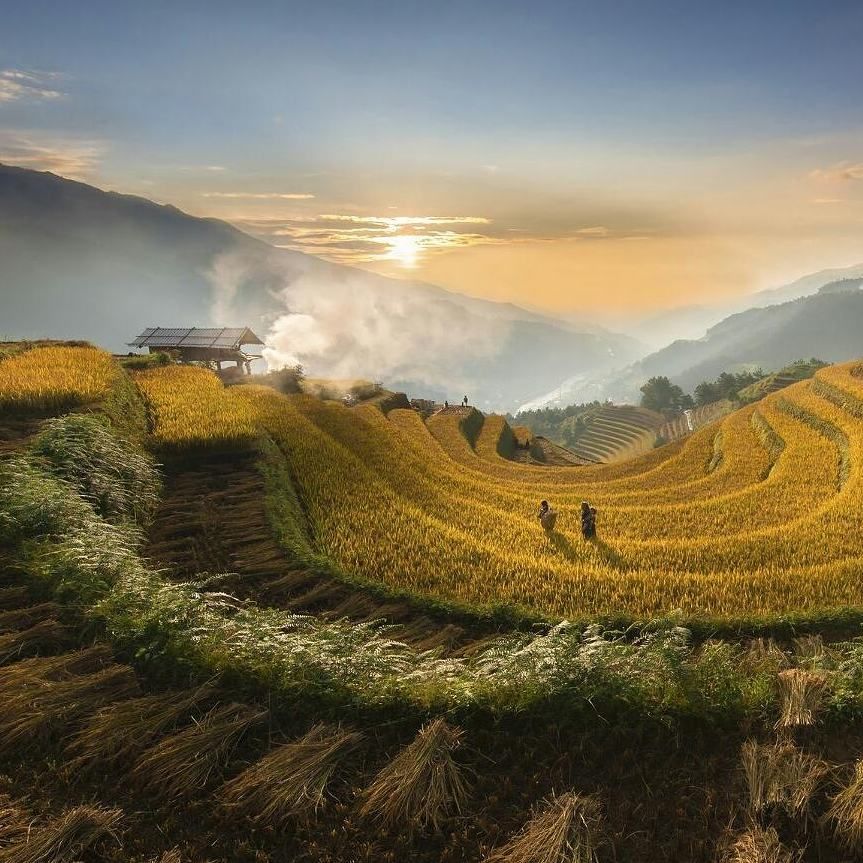
Vietnam has a tropical climate with four distinct seasons: spring (February-April), summer (May-August), autumn (September-November), and winter (December-January). The best time to travel to Vietnam depends on which region you want to visit, as each one has different weather patterns and attractions. Generally speaking, spring (Feb to April) and autumn (August to October) are considered the best seasons for traveling across Vietnam, as they offer pleasant temperatures, low rainfall, and clear skies. However, you can also enjoy Vietnam in any season if you plan ahead and pack accordingly.
Here are some of the pros and cons of each season:
- Spring: This is a great time to see the flowers blooming in northern Vietnam, especially in Sa Pa and Ha Giang provinces. You can also celebrate Tet (Vietnamese New Year) in late January or early February with locals and enjoy their festive traditions. However, spring can also be crowded with domestic tourists and prices may be higher than usual.
- Summer: This is a good time to enjoy the beaches and islands of central and southern Vietnam, such as Da Nang, Hoi An, Nha Trang, Phu Quoc, and Con Dao. You can also witness some colorful festivals such as Hue Festival in April or Da Nang International Fireworks Festival in June. However, summer can also be very hot and humid, with frequent rainstorms and typhoons.
- Autumn: This is a perfect time to admire the golden rice terraces in northern Vietnam, especially in Mu Cang Chai and Yen Bai provinces. You can also enjoy the cooler weather and the changing colors of the leaves in the mountains. However, autumn can also be prone to flooding and landslides in some areas, especially in October and November.
- Winter: This is a nice time to experience the snow and frost in northern Vietnam, especially in Sa Pa and Mau Son. You can also celebrate Christmas and New Year with locals and expats in the cities. However, winter can also be very cold and foggy, with limited visibility and activities.
Here is a general overview of the best time to visit Vietnam by month:
- January: The weather is dry and sunny in most parts of Vietnam, making it a good time to visit popular tourist destinations like Ha Long Bay and Hoi An. However, it can be cold in the north,
- February: The weather is still good in January, but the crowds start to thin out as the peak season comes to an end. This is a good time to visit if you are looking for a more relaxed vacation.
- March: The weather starts to get warmer in the south, making it a good time to visit beaches like Phu Quoc and Nha Trang. However, it can be hot and humid in the north. Looking for exciting activities? Discover a plethora of things to do in Phú Quốc and Nha Trang.
- April: The weather is hot and sunny in most parts of Vietnam. This is the start of the peak season, so expect crowds and higher prices.
- May: The weather is at its hottest and most humid in May. It is also the start of the rainy season in the north.
- June: The rainy season starts in the north and central Vietnam, but the south remains dry. This is a good time to visit the Mekong Delta, as the water levels are high and the scenery is lush.
- July: The rainy season is in full swing in the north and central Vietnam. However, the south remains dry and sunny. This is a good time to visit beaches in the south, as the crowds have thinned out.
- August: The rainy season starts to taper off in the north and central Vietnam. However, it can still be wet and humid.
- September: The weather is starting to get cooler in the north and central Vietnam. This is a good time to visit popular tourist destinations like Ha Long Bay and Sapa, as the crowds have thinned out.
- October: The weather is dry and sunny in most parts of Vietnam, making it a good time to visit any region of the country.
- November: The weather is still good in November, but the crowds start to pick up again as the holiday season approaches.
- December: The weather is dry and sunny in most parts of Vietnam, making it a good time to visit popular tourist destinations like Ha Long Bay and Hoi An. However, it can be cold in the north, especially in the mountainous regions.
Top tourist destinations in Vietnam
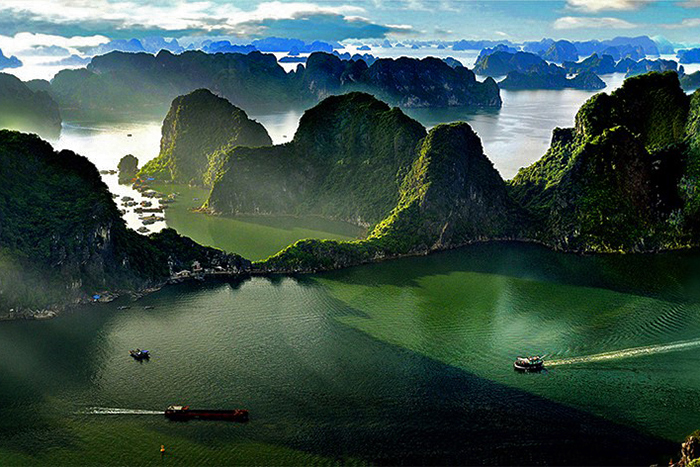
If you are looking for some of the top tourist destinations in Vietnam, you have plenty of options to choose from. Vietnam has something for everyone, whether you prefer bustling cities or serene countryside. Here are some of the places you should not miss:
- Hanoi, the capital of Vietnam, is a vibrant city with a rich history and culture. Visitors can explore the Old Quarter, a maze of narrow streets and alleyways lined with shops, restaurants, and temples. They can also visit the Ho Chi Minh Mausoleum, the Temple of Literature, and the One Pillar Pagoda.
- Ha Long Bay: A UNESCO World Heritage Site, Ha Long Bay is a stunning archipelago of over 1,600 islands and islets. The limestone karsts and emerald waters of Ha Long Bay are a popular destination for boat tours, kayaking, and swimming. You can also explore the caves, grottoes, floating villages, and pearl farms that dot the bay. Ha Long Bay is one of the New Seven Wonders of Nature and a must-see for any traveler.
- Cat Ba Island, an island in Ha Long Bay, is a popular destination for hiking, kayaking, and scuba diving. Visitors can explore the island's lush rainforests, visit its hidden coves and beaches, and view its stunning limestone karsts.
- Sapa: A mountain town in northern Vietnam, Sapa is a paradise for nature lovers and adventure seekers. You can marvel at the breathtaking scenery of rice terraces, valleys, and peaks that change color with the seasons. You can also trek, hike, bike, or homestay with the ethnic minority groups that live in the area. Sapa is a place to experience the local culture, markets, festivals, and customs of these diverse communities. Sapa is also a gateway to other attractions in northern Vietnam, such as Fansipan Mountain, Muong Hoa Valley, and Bac Ha Market.
- Ha Giang, a province in the northeast of Vietnam, is known for its stunning scenery, including the Ha Giang Loop, a popular motorcycle route. Visitors can hike through the mountains, visit ethnic minority villages, and explore the region's natural beauty.
- Mai Chau, a valley in north-central Vietnam, is home to the Black Thai, White Thai, and Muong ethnic minority groups. Visitors can experience the traditional culture of these groups by visiting their villages and participating in their activities.
- Ninh Binh: Nestled in north-central Vietnam, Ninh Binh shines as the home to the extraordinary Tam Coc Karst Landscape and Cuc Phuong National Park. Boat tours through the Ha Long Bay-like landscape and encounters with the diverse flora and fauna bring this region's natural beauty to life.
- Nha Trang: A beach resort city in central Vietnam, Nha Trang is known for its beautiful beaches, clear waters, and coral reefs. It is a popular destination for swimming, sunbathing, and water sports.
- Hoi An: A UNESCO World Heritage Site, Hoi An is a charming town in central Vietnam. It is known for its well-preserved traditional architecture, including Chinese shophouses and Japanese merchant houses. Hoi An is also a major center for silk production and tailoring. You can shop for custom-made clothes, lanterns, pottery, and other souvenirs at the colorful markets and shops. Hoi An also has a rich culinary scene, with dishes like cao lau, banh xeo, and mi quang. Don't forget to visit the nearby beaches and countryside for some relaxation and adventure.
- Da Nang: This coastal city's allure lies in its pristine beaches and dramatic landscapes. From the heights of Ba Na Hills to the wonders of Marble Mountains, Da Nang caters to adventurers and nature enthusiasts alike.
- Hue: The former imperial capital of Vietnam, Hue is a showcase of the country's royal heritage. You can visit the citadel, palaces, tombs, pagodas, and temples that are part of the UNESCO World Heritage Site. You can also admire the art, culture, and cuisine of the Nguyen Dynasty, which ruled Vietnam from 1802 to 1945. Hue is famous for its elegant dishes like bun bo hue, banh beo, and com hen. You can also enjoy the scenic views of the Perfume River and the surrounding mountains.
- Phong Nha-Ke Bang National Park, a UNESCO World Heritage Site, is home to the world's largest cave system. Visitors can take a tour of the caves, go kayaking on the Son River, or hike in the park's rainforests.
- Mui Ne, a beach resort town in southern Vietnam, is known for its sand dunes, windsurfing, and kitesurfing. Visitors can relax on the beach, go sandboarding or dune bashing, or go windsurfing or kitesurfing.
- Ho Chi Minh City: The largest and most dynamic city in Vietnam, Ho Chi Minh City is a blend of modern and historic influences. You can learn about the country's past at the War Remnants Museum, the Reunification Palace, and the Cu Chi Tunnels. You can also enjoy the city's present at the Bitexco Financial Tower, the Notre Dame Cathedral, and the Saigon Opera House. Ho Chi Minh City is also a great place to experience the nightlife, shopping, and street food of Vietnam. You can find everything from luxury malls to local markets, from fine dining to street stalls.
- Mekong Delta: The sprawling Mekong Delta in southern Vietnam is characterized by lush rice paddies, floating markets, and traditional villages. Guided boat tours, market explorations, and countryside hikes unveil the delta's vibrant way of life and natural splendor.
- Phu Quoc: Off the southern coast, Phu Quoc beckons with its idyllic beaches and luxury resorts. This island paradise offers sun-soaked relaxation and the chance to explore its national park's unspoiled beauty.
Things to do in Vietnam
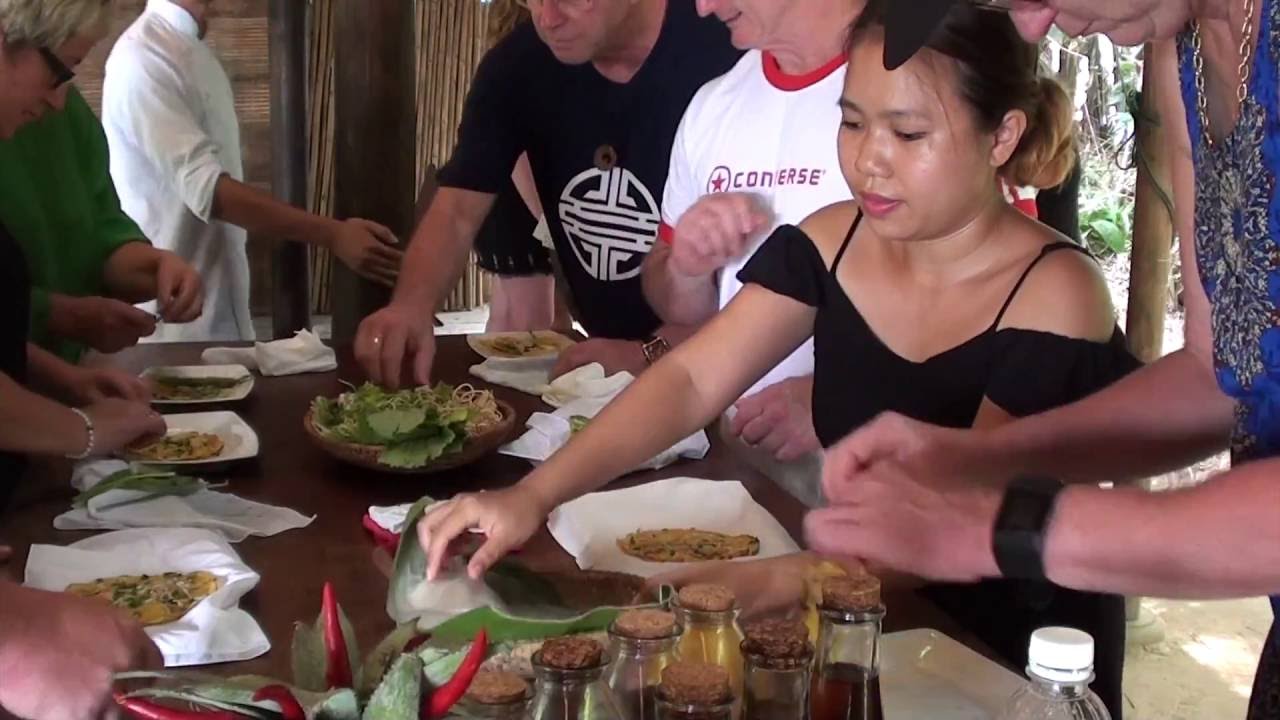
From stunning natural landscapes to rich history and culture, there's no shortage of things to see and do in Vietnam. Here are Vicky's top things to do in Vietnam:
- Visit Hanoi, the capital city of Vietnam, where you can experience the old and the new, the traditional and the modern. Hanoi is a vibrant and lively city, full of history, culture, and charm. You can explore the Old Quarter, where you can see the ancient architecture, shop at the colorful markets, and taste the delicious street food. You can also visit the Temple of Literature, the Ho Chi Minh Mausoleum, the Hoan Kiem Lake, and the Water Puppet Theater.
- Cruise on Ha Long Bay, one of the most scenic and iconic places in Vietnam. Ha Long Bay is a UNESCO World Heritage Site, where thousands of limestone islands and islets rise from the emerald waters of the Gulf of Tonkin. you can take a cruise on a traditional junk boat, kayak through the caves and grottoes, or visit the floating villages and pearl farms. You can also stay overnight on the boat and watch the sunrise and sunset over the bay.
- Climb the limestone karsts of Ninh Binh. Ninh Binh is a province in north-central Vietnam known for its Tam Coc Karst Landscape, a UNESCO World Heritage Site. Be sure to take a boat tour through the caves and grottos of Tam Coc, or hike to the top of the Mua Caves.
- Explore Sapa Valley and Bac Ha Market, where you can enjoy the stunning views of the rice terraces, valleys, and peaks. Sapa is a mountainous town in northern Vietnam, where you can trek, hike, bike, or homestay with the ethnic minority groups that live in the area. You can also visit Bac Ha Market, one of the largest and most colorful markets in Vietnam, where you can see the local people in their traditional costumes selling their products and handicrafts.
- Explore the ancient trading port of Hoi An, a UNESCO World Heritage Site known for its well-preserved traditional architecture. Take a walk through the Old Town, visit the Japanese Covered Bridge, and shop for souvenirs at the night market.
- Visit the ancient temples of My Son. My Son is an ancient Hindu temple complex located in the central highlands of Vietnam. It was once the capital of the Champa Kingdom, which flourished from the 7th to the 15th centuries.
- Relax on the beaches of Da Nang or Nha Trang. These two coastal cities are home to beautiful beaches and a variety of activities, such as swimming, sunbathing, and water sports.
- Discover Hue Imperial City (The Citadel), the former imperial capital of Vietnam, where you can witness the grandeur and glory of the Nguyen Dynasty. Hue is famous for its citadel, palaces, tombs, pagodas, and temples, which are also UNESCO World Heritage Sites. Hue is also known for its royal cuisine, art, and culture
- Discover the bustling metropolis of Ho Chi Minh City, formerly known as Saigon. Visit the Cu Chi Tunnels, a network of underground tunnels used by the Viet Cong during the Vietnam War, and shop for souvenirs at Ben Thanh Market. Visit the War Remnants Museum, a sobering reminder of the Vietnam War.
- Explore the Mekong Delta, a vast river delta known for its floating markets, traditional villages, and lush green rice paddies. Take a boat tour to see the floating markets and visit a traditional village.
- See the Cu Chi Tunnels. These underground tunnels were used by the Viet Cong during the Vietnam War. You can take a tour of the tunnels to learn about the war and the ingenuity of the Vietnamese people.
- Relax on the beaches of Phu Quoc, an island off the coast of southern Vietnam known for its beautiful beaches and resorts. Go swimming, sunbathing, and exploring the island's national park.
Where to Stay in Vietnam
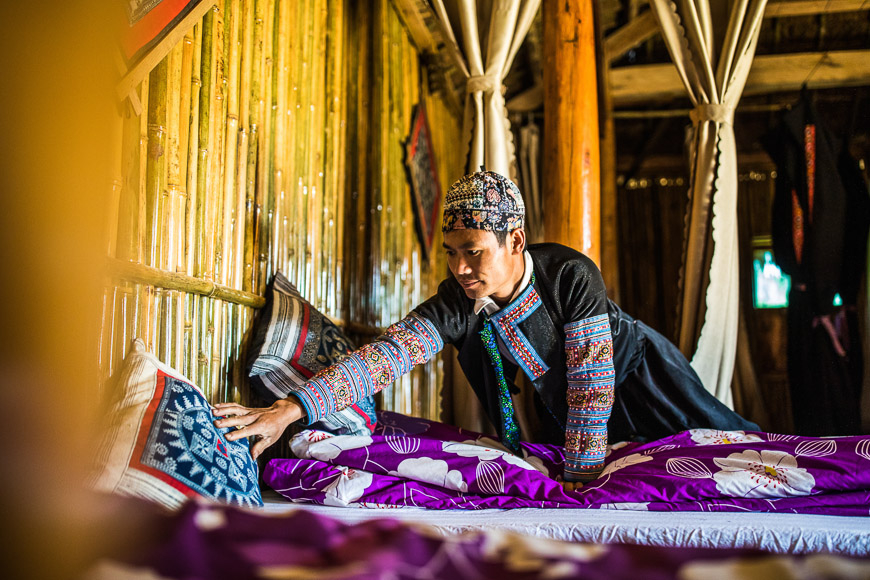
Vietnam offers a wide range of accommodation options for travelers of all budgets and preferences. You can find everything from luxury hotels and resorts to budget hostels and homestays.
Please kindly note that the information provided on hotel booking websites such as Agoda or Booking should be considered as a reference only. Some details on these platforms might not be accurate due to infrequent updates, especially for accommodations in remote areas or budget hotels. The best approach for a satisfying experience is to opt for a comprehensive package tour that includes hotels, related services, and land tours. Local experts are well-equipped to select the optimal hotels and services to ensure the best possible experience for your trip. For instance, even though both hotels are rated as 3 stars in Hanoi, if you were to book a 3-star hotel in Thanh Xuan district, you might secure a double room for around $30 (with certain facility limitations). However, a similarly rated 3-star hotel with comparable or slightly better amenities in the Old Quarter of Hanoi could cost you around $45.
Here are some of the factors to consider when choosing where to stay in Vietnam:
- Location: You should choose a location that is convenient for your travel plans and interests. For example, if you want to explore the historical and cultural attractions of Hanoi or Ho Chi Minh City, you should stay near the old quarter or the city center. If you want to enjoy the beach and nature of Da Nang or Nha Trang, you should stay near the coast or the mountains. If you want to experience the rural life of Sa Pa or Mai Chau, you should stay in a village or a farm.
- Price: You should choose a price that suits your budget and expectations. For example, if you want to splurge on a luxurious stay with all the amenities and services, you should expect to pay around $100-$300 per night for a five-star hotel or resort. If you want to save money on a basic stay with minimal facilities and comfort, you should expect to pay around $40-$70 per night for a 3-star hotel or hostel. You can also find many mid-range options that offer decent quality and value for around $60-$100 per night. You can use the Booking.Com or Agoda to compare prices and reviews of different accommodation options in Vietnam.
Style: You should choose a style that matches your taste and personality. For example, if you want to experience the local culture and hospitality, you should stay in a homestay or a guesthouse, where you can interact with the host family and enjoy their home-cooked meals. If you want to indulge in the colonial charm and elegance, you should stay in a heritage hotel or a villa, where you can admire the architecture and decor of the French or Chinese influence. If you want to relax in the modern comfort and convenience, you should stay in a chain hotel or a serviced apartment, where you can access the facilities and amenities of the international standards.
Amenities: You should choose amenities that suit your needs and preferences. For example, if you want to stay connected and productive, you should look for a place that offers free Wi-Fi, a work desk, and a power outlet. If you want to stay fit and healthy, you should look for a place that offers a gym, a pool, and a spa. If you want to stay entertained and social, you should look for a place that offers a bar, a restaurant, and a game room.
When choosing a place to stay in Vietnam, it is important to consider your budget, interests, and travel style. If you are on a budget, there are many affordable hostels and guesthouses available. If you are looking for luxury accommodations, there are many beautiful hotels and resorts to choose from. If you are interested in history and culture, you may want to stay in a city like Hanoi or Ho Chi Minh City. If you are looking for a more relaxing beach vacation, you may want to stay in a resort on Phu Quoc or Nha Trang.
Here are some of the best places to stay in Vietnam, depending on your interests and budget:
- Hanoi: The capital of Vietnam, Hanoi is a bustling city with a rich history and culture. There are many things to see and do in Hanoi, from visiting the Ho Chi Minh Mausoleum to exploring the Old Quarter. There are a variety of accommodation options in Hanoi, from budget hostels to luxurious hotels.
- Ho Chi Minh City: Formerly known as Saigon, Ho Chi Minh City is the largest city in Vietnam. It is a vibrant and cosmopolitan city with a mix of French colonial and Vietnamese architecture. There are many things to see and do in Ho Chi Minh City, from visiting the Cu Chi Tunnels to shopping at Ben Thanh Market.
- Da Nang: A coastal city in central Vietnam, Da Nang is known for its beautiful beaches and stunning scenery. There are many things to see and do in Da Nang, from hiking in Ba Na Hills to exploring the Marble Mountains.
- Ninh Binh: A province in north-central Vietnam, Ninh Binh is home to the stunning Ha Long Bay. There are many things to see and do in Ninh Binh, from boat tours of Ha Long Bay to visiting
- Hoi An: A UNESCO World Heritage Site, Hoi An is a charming town in central Vietnam. It is known for its well-preserved traditional architecture and its vibrant silk industry. There are many things to see and do in Hoi An, from visiting the Japanese Covered Bridge to shopping for souvenirs at the night market.
- Phu Quoc: An island off the coast of southern Vietnam, Phu Quoc is known for its beautiful beaches and luxurious resorts. There are many things to see and do in Phu Quoc, from swimming and sunbathing to exploring the island's national park.
How to get around Vietnam
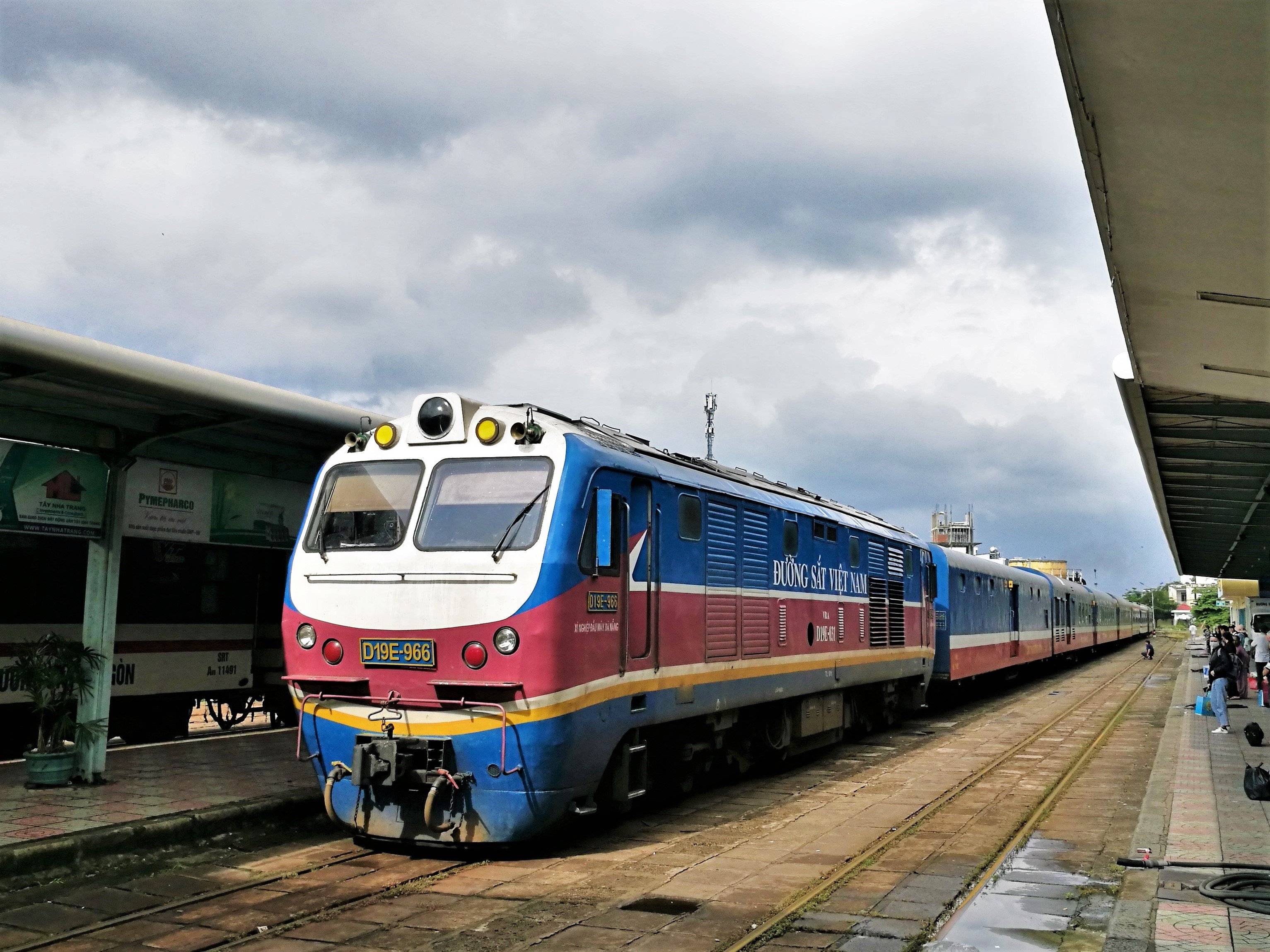
Vietnam is a large and diverse country with a lot to offer visitors. Whether you're interested in history, culture, nature, or food, you're sure to find something to love in Vietnam. One of the best things about Vietnam is the ease of getting around. The country has a well-developed transportation system that makes it easy to get to your destination, no matter where you're going.
Here are some of the most common ways to get around Vietnam:
- By plane: This is the fastest and easiest way to get from one city to another in Vietnam, especially if you are short on time or want to cover a long distance. There are many domestic flights that connect the major destinations in Vietnam, such as Hanoi, Ho Chi Minh City, Da Nang, Hue, Nha Trang, and Phu Quoc. You can find cheap and reliable airlines such as Vietnam Airlines, Vietjet, Bamboo Airways, and Pacific Airlines. Vietnam Airlines, Vietnam's national carrier, boasts a 4-star rating and exceptional services, often regarded as the country's finest. Bamboo Airways, a newcomer, focuses on the domestic market, aspiring to achieve a high-quality 4-star status. Other airlines primarily offer budget options, requiring careful consideration before booking to match your preferences.
- By train: Vietnam has a main railroad that goes from Saigon (Ho Chi Minh City) in the south to Hanoi in the north, with over 20 stops along the way. The railroad covers more than 1,000 miles along the coast, linking almost all major coastal cities between Saigon and Hanoi. This railroad is called the 'Reunification Express' today. There are at least 6 trains every day in both directions on the 'Reunification Express' between Saigon and Hanoi. The trip between the two cities takes about 34 hours to 36 hours. Besides, there are some other trains that run on specific sections of the main railroad, stopping at smaller and bigger stations. Besides the main 'Reunification Express' route, there are some other routes that go to different places. These include: Hanoi → Hải Phòng, Hanoi → Lào Cai, Hanoi → Lạng Sơn, Hanoi → Hạ Long, Hanoi → Thái Nguyên, and Saigon → Phan Thiết. However, the schedules on these routes are not regular and may change, especially after the pandemic.You can easily check the schedules, times and ticket prices at the official website of Vietnam railway: [https://dsvn.vn/#/timve]
This is a scenic and comfortable way to travel in Vietnam, especially if you want to enjoy the views of the countryside and the coast. There is a single railway network that runs from north to south, linking Hanoi and Ho Chi Minh City. You can also find trains that stop at other popular destinations such as Hue, Da Nang, Nha Trang, and Sapa. You can choose from different types of seats and cabins, depending on your budget and comfort level. - By bus: This is a cheap and flexible way to travel in Vietnam, especially if you want to explore the off-the-beaten-path places or meet other travelers. There are two types of buses in Vietnam: tourist buses and local buses. Tourist buses are catered for tourists and hit all the major attractions. They usually pick up from the city center or your hotel and offer more comfort and safety than local buses. Local buses are used by locals and offer a more authentic and adventurous experience. They usually depart from bus stations or random spots on the road and offer lower prices but less quality and reliability than tourist buses.
- Taxi: Taxis are a good option for getting around in cities. They are relatively inexpensive, and they can be hailed on the street or booked through a taxi app.
- Grab: Grab is a ride-hailing app that is popular in Vietnam. It is a convenient and affordable way to get around, and it offers a variety of vehicles, including cars, motorbikes, and bicycles. Formerly present in Vietnam, Uber has since been acquired by Grab. As a result, Grab is the only ride-hailing app available in Vietnam now, with Uber no longer operating in the country's market.
- By motorbike: This is an adventurous and independent way to travel in Vietnam, especially if you want to experience the thrill of riding on the roads and discovering every corner of the country. Motorbikes are the most popular mode of transportation in Vietnam, for locals and tourists alike. You can rent or buy a motorbike from many shops or online platforms in Vietnam. You can also join a motorbike tour or hire a driver if you don't want to ride by yourself. You will need a valid driver's license, an international driving permit, a vehicle registration certificate, a vehicle insurance certificate, and a helmet to ride a motorbike in Vietnam. You should also be careful of the traffic rules, road conditions, and weather in Vietnam.
Cultural tips for Vietnam
Vietnam has a long and complex history of interactions with different countries and civilizations, such as China, France, Japan, and the United States. This has shaped the culture of Vietnam, which is influenced by Confucianism, Buddhism, Taoism, Christianity, and other beliefs and values. Vietnam also has 54 ethnic groups, each with their own customs and traditions. Therefore, it is important to be respectful and aware of the cultural differences and etiquette when visiting Vietnam. Here are some of the cultural tips that you should know before traveling to Vietnam:
- Greetings: When greeting Vietnamese people for the first time, you should avoid physical contact, such as hugs and kisses, unless they initiate it. Shaking hands is common among men, but not between the opposite sex or with seniors. You should greet the elderly first, and bow your head slightly. You should also address people by their title and surname, or by their relationship to you. For example, you can call an older man "ông" (grandfather), an older woman "bà" (grandmother), a younger man "anh" (older brother), or a younger woman "chị" (older sister). You can also use "xin chào" (hello) or "chào bạn" (hello friend) as a general greeting.
- Face: Face is the concept of preserving one's dignity and respect in Vietnamese culture. It can be given, saved, or lost, depending on one's actions and words. Vietnamese people tend to avoid public confrontation or criticism, as they may cause someone to lose face. Therefore, you should try to be polite, calm, and humble when dealing with Vietnamese people. You should also avoid pointing out mistakes or faults in public or in front of others. If you have to do so, you should do it discreetly and tactfully.
- Dining: Dining is an important part of Vietnamese culture, as it is a way of expressing hospitality and friendship. Vietnamese people usually eat together in a family or group setting, sharing dishes from a common plate. You should wait for the host or the eldest person to invite you to start eating before you do so. You should also use both hands to pass or receive food or drinks. You should avoid sticking your chopsticks upright in your rice bowl, as it is considered rude and unlucky. You should also avoid pointing your chopsticks at someone or waving them around.
- Gifts: Giving gifts is a common way of showing gratitude and respect in Vietnamese culture. You should bring a small gift when visiting someone's home or meeting someone for the first time. Some of the appropriate gifts are fruits, flowers, sweets, tea, coffee, wine, or books. You should avoid giving sharp objects, such as knives or scissors, as they may imply cutting off the relationship. You should also avoid giving handkerchiefs, clocks, or anything black or white, as they are associated with death and mourning.
- Dress: Dressing appropriately is another way of showing respect and sensitivity in Vietnamese culture. You should dress modestly and conservatively when visiting religious sites or rural areas. You should cover your shoulders and knees and remove your shoes before entering a temple or a pagoda. You should also avoid wearing hats or sunglasses inside these places.
Here are a few cultural tips to help you have a more enjoyable and respectful visit:
- Vietnamese people are generally very friendly and welcoming. It's a good idea to learn a few basic Vietnamese phrases, such as "hello," "goodbye," "thank you," and "you're welcome."
- Vietnam is a collectivist society, so it's important to be respectful of others' space. Don't be surprised if people stand close to you or touch you in public.
- Vietnam is a Buddhist country, so it's important to be respectful of Buddhist customs. Avoid wearing shorts or sleeveless shirts in temples or pagodas.
- Vietnamese people are very proud of their country's history and culture. It's a good idea to do some research before you go so you can appreciate the country's unique culture.
- Vietnam is a tropical country, so it's important to be prepared for the heat and humidity. Wear light, loose-fitting clothing and drink plenty of fluids.
- Vietnam is a relatively affordable country, so you can travel on a budget. However, it's a good idea to have some cash on hand, as credit cards are not always accepted.
- Vietnam is a safe country, but it's always a good idea to be aware of your surroundings. Don't leave valuables unattended, and be careful walking at night in unfamiliar areas.
Safety tips for Vietnam
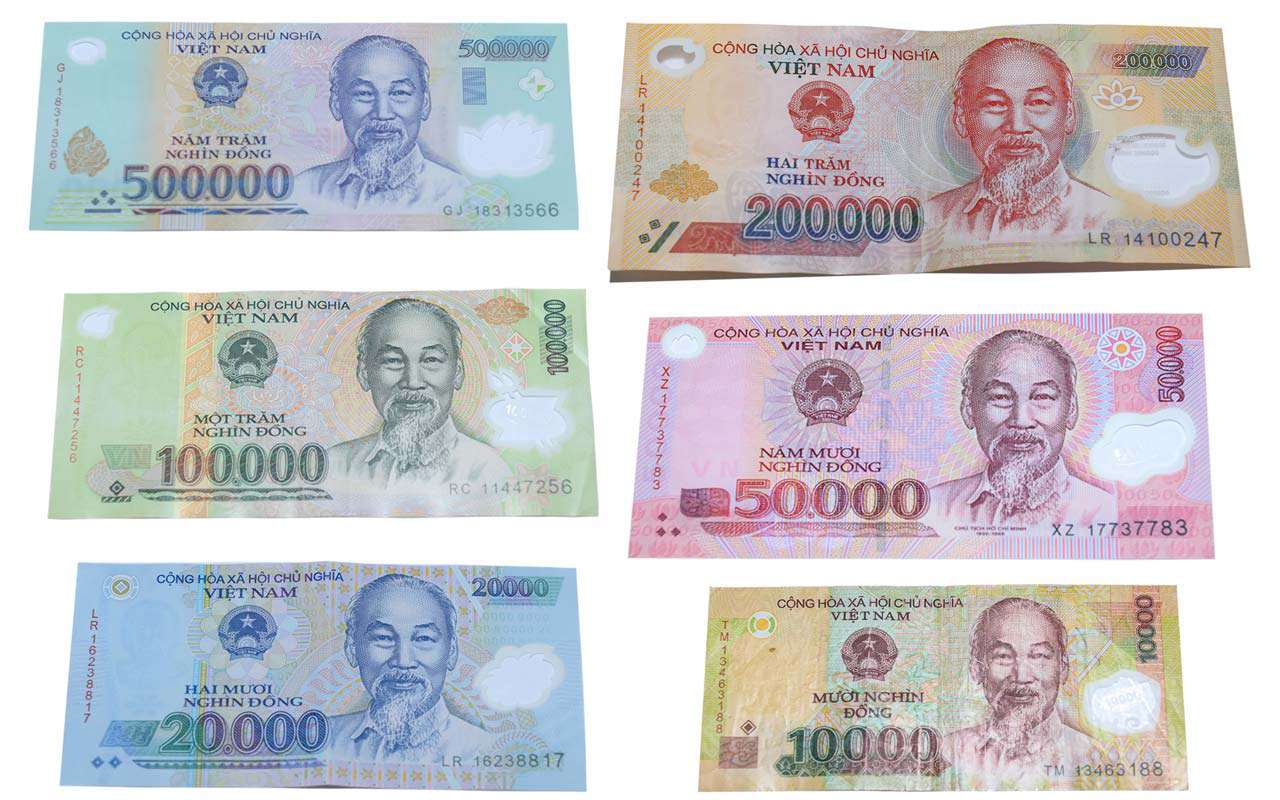
Vietnam is a safe country to visit, but it's always a good idea to be aware of your surroundings and take some basic precautions. Here are a few safety tips for Vietnam:
- Be aware of your surroundings. Don't walk around with your head down or your phone out. Be aware of your surroundings and keep an eye out for potential pickpockets or scammers. Vietnam is generally a safe country for tourists, but petty crimes such as pickpocketing, bag snatching, and scams can happen. Therefore, you should be vigilant and cautious when walking around crowded or touristy areas, such as markets, bus stations, or attractions. You should also avoid walking alone at night or in dark alleys. You should keep your valuables and documents in a safe place or leave them at your hotel. You should also be wary of strangers who approach you with offers or requests that seem too good to be true.
- Don't carry large amounts of cash or valuables. Keep your valuables in a safe place, such as a money belt or a hidden pocket.
- Be careful crossing the street. One of the biggest hazards in Vietnam is the traffic, especially in big cities like Hanoi and Ho Chi Minh City. The roads are often crowded and chaotic, with motorbikes, cars, buses, bicycles, and pedestrians sharing the same space. The traffic rules are not always followed or enforced, and accidents are common. Therefore, you should be very careful when crossing the street, riding a motorbike, or taking a taxi. You should always look both ways, walk at a steady pace, and avoid sudden movements. You should also wear a helmet, follow the traffic signs and signals, and negotiate the fare before getting into a taxi.
- Drink bottled water. Tap water in Vietnam is not safe to drink. Drink bottled water instead.
- Health: Vietnam has a tropical climate with four distinct seasons: spring (February-April), summer (May-August), autumn (September-November), and winter (December-January). The weather can vary depending on the region and the time of the year. Therefore, you should check the weather forecast before your trip and pack accordingly. You should also protect yourself from the sun, heat, insects, and waterborne diseases. You should wear sunscreen, sunglasses, and hats. You should drink plenty of water and avoid dehydration. You should use insect repellent and wear long sleeves and pants. You should also avoid raw or undercooked food.
- Be respectful of Vietnamese culture. You should be respectful and aware of the cultural differences and etiquette when visiting Vietnam. Dress modestly and avoid making any offensive gestures or comments. You should greet people with a smile and a nod. You should avoid physical contact or public displays of affection. You should dress modestly and conservatively when visiting religious sites or rural areas. You should remove your shoes before entering a temple or a house. You should avoid pointing your finger or your feet at someone or something.
However, there is more to Vietnam than just safety concerns. Vietnam is a beautiful country with many attractions that appeal to different types of travelers, from bustling cities to serene countryside. If you want to make the most of your trip to Vietnam, you should consider booking tour packages from local tour operators who are reputable and experienced in providing private and escorted tours in Vietnam.
Some of the benefits and values of using local tour operators are:
- They can offer you customized itineraries that suit your interests and preferences.
- They can provide you with knowledgeable guides who can speak your language and share their insights and stories about Vietnam.
- They can arrange your transportation, accommodation, meals, tickets, and other services that can save you time and hassle.
- They can ensure your safety and comfort throughout your trip.
- They can support the local economy and community by hiring local staff and using local products.
One of the local tour operators that I recommend is Travel Vietnam, which has been providing high-quality tours in Vietnam since 2006, and I am proud to have been a dedicated member of this company since 2009. We have a team of professional travel consultants, including myself, who can help you plan your dream trip to Vietnam! We have a variety of tour packages that cover all the major destinations in Vietnam, such as Hanoi, Halong Bay, Sapa, Hoi An, Hue, Da Nang, Ho Chi Minh City, and Mekong Delta.
We also have special interest tours that cater to different themes, such as culture, nature, adventure, cuisine, or wellness. We also have flexible options that allow you to customize your own tour according to your budget, schedule, and style. If you are interested in booking a tour with TravelVietnam.Com, you can contact us by email or phone/WhatsApp. You can also read our reviews on TripAdvisor or Trustpilot to see what our customers say about our services.
There are many reputable local tour operators in Vietnam. TravelVietnam.com is one of them. TravelVietnam.com offers a variety of private and escort tours, including tours of Sapa, Hanoi, Ha Long Bay, Ninh Binh, Hoi An, Mekong Delta, and Ho Chi Minh City.
Here are a few of the benefits of traveling with Travel Vietnam:
- Safety: We specialize exclusively in offering private and luxury tours in Vietnam, serving as a reliable Vietnam DMC (Destination Management Company). Our dedicated tour guides and drivers escort you throughout the journey, prioritizing the absolute safety of you and your group. With our expertise in organizing Vietnam school tours and MICE (Meetings, Incentives, Conferences, and Exhibitions) tours, we are well-equipped to provide comprehensive services that ensure your trip is not only secure but also unforgettable. By teaming up with us, you can rest assured, as we help you avoid scams and potential safety concerns while exploring the wonders of Vietnam.
- Convenience: We are a local tour operator that can handle all of the details of your trip, so you can relax and enjoy your vacation.
- Knowledge: With over 19 years of experience in the travel industry, we boast a seasoned team of travel experts. With offices in multiple countries such as Bangkok, Luang Prabang, Siem Reap, Yangon, Hanoi, and HCM City, we are well-equipped to ensure a memorable journey for you. This local presence allows us to offer insights into local culture and history, making your travel experience truly remarkable.
Last updated on 2024-04-25 06:56:52.
Other Travel Planning
- How to Travel to Vietnam from South Africa
- Best Time to Visit Vietnam and Cambodia: A Complete Guide for 2024
- Reasons To Visit Vietnam In The Green Season
- Hanoi Travel Guide: Everything You Need to Know Before You Go
- Vietnam Tour Packages from Singapore
- Travel to Vietnam from Spain
- Can i get a visa upon arrival in Vietnam?
- Vietnam Tours from Bangkok
- What is the capital of Vietnam and why you should visit it
- Vietnam: the value of traveling

